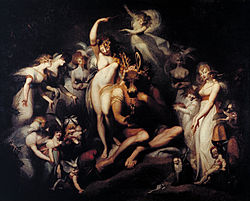
A Midsummer Night's Dream is a comedy play written by William Shakespeare in about 1595 or 1596. The play is set in Athens, and consists of several subplots that revolve around the marriage of Theseus and Hippolyta. One subplot involves a conflict among four Athenian lovers. Another follows a group of six amateur actors rehearsing the play which they are to perform before the wedding. Both groups find themselves in a forest inhabited by fairies who manipulate the humans and are engaged in their own domestic intrigue. A Midsummer Night's Dream is considered one of Shakespeare's most popular and widely performed plays.

Brian Froud is an English fantasy illustrator and conceptual designer. He is most widely known for his 1978 book Faeries with Alan Lee, and as the conceptual designer of the Jim Henson films The Dark Crystal (1982) and Labyrinth (1986). According to Wired, Froud is "one of the most pre-emiminent visualizers of the world of faerie and folktale".
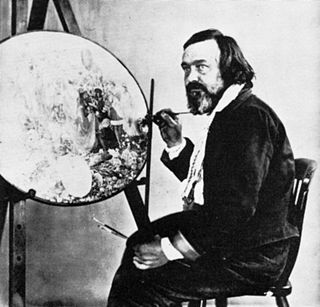
Richard Dadd was an English painter of the Victorian era, noted for his depictions of fairies and other supernatural subjects, Orientalist scenes, and enigmatic genre scenes, rendered with obsessively minuscule detail. Most of the works for which he is best known were created while he was a patient in Bethlem and Broadmoor hospitals.

Sir John Everett Millais, 1st Baronet was an English painter and illustrator who was one of the founders of the Pre-Raphaelite Brotherhood. He was a child prodigy who, aged eleven, became the youngest student to enter the Royal Academy Schools. The Pre-Raphaelite Brotherhood was founded at his family home in London, at 83 Gower Street. Millais became the most famous exponent of the style, his painting Christ in the House of His Parents (1849–50) generating considerable controversy, and he produced a picture that could serve as the embodiment of the historical and naturalist focus of the group, Ophelia, in 1851–52.

The Pre-Raphaelite Brotherhood was a group of English painters, poets, and art critics, founded in 1848 by William Holman Hunt, John Everett Millais, Dante Gabriel Rossetti, William Michael Rossetti, James Collinson, Frederic George Stephens and Thomas Woolner who formed a seven-member "Brotherhood" partly modelled on the Nazarene movement. The Brotherhood was only ever a loose association and their principles were shared by other artists of the time, including Ford Madox Brown, Arthur Hughes and Marie Spartali Stillman. Later followers of the principles of the Brotherhood included Edward Burne-Jones, William Morris and John William Waterhouse.

Oberon is a king of the fairies in medieval and Renaissance literature. He is best known as a character in William Shakespeare's play A Midsummer Night's Dream, in which he is King of the Fairies and spouse of Titania, Queen of the Fairies.

Gabriel Charles Dante Rossetti, generally known as Dante Gabriel Rossetti, was an English poet, illustrator, painter, translator, and member of the Rossetti family. He founded the Pre-Raphaelite Brotherhood in 1848 with William Holman Hunt and John Everett Millais. Rossetti inspired the next generation of artists and writers, William Morris and Edward Burne-Jones in particular. His work also influenced the European Symbolists and was a major precursor of the Aesthetic movement.

Frederic George Stephens was a British art critic, and one of the two 'non-artistic' members of the Pre-Raphaelite Brotherhood.
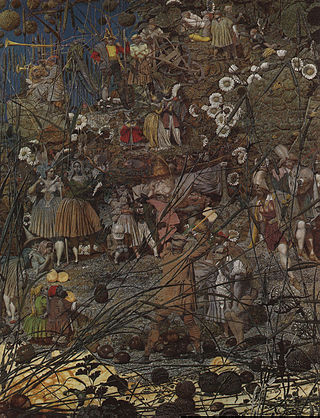
The Fairy Feller's Master-Stroke is a painting by English artist Richard Dadd. It was begun in 1855 and worked on until 1864. Dadd painted it while incarcerated in the State Criminal Lunatic Asylum of Bethlem Royal Hospital, where he was confined after he murdered his father in 1843. It was commissioned by George Henry Haydon, who was head steward of the hospital at the time.
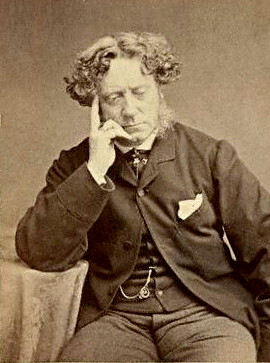
Sir Joseph Noel Paton was a Scottish artist, illustrator and sculptor. He was also a poet and had an interest in, and knowledge of, Scottish folklore and Celtic legends.
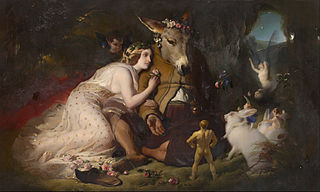
Titania is a character in William Shakespeare's 1595–1596 play A Midsummer Night's Dream.
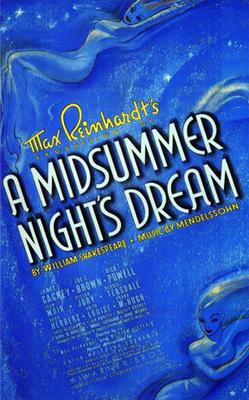
A Midsummer Night's Dream is a 1935 American romantic comedy fantasy film of William Shakespeare's play, directed by Max Reinhardt and William Dieterle, and starring James Cagney, Mickey Rooney, Olivia de Havilland, Jean Muir, Joe E. Brown, Dick Powell, Ross Alexander, Anita Louise, Victor Jory and Ian Hunter. Produced by Henry Blanke and Hal B. Wallis for Warner Brothers, and adapted by Charles Kenyon and Mary C. McCall Jr. from Reinhardt's Hollywood Bowl production of the previous year, the film is about the events surrounding the marriage of the Duke of Athens, Theseus, and the Queen of the Amazons, Hippolyta. These include the adventures of four young Athenian lovers and a group of six amateur actors, who are controlled and manipulated by the fairies who inhabit the forest in which most of the story is set. The play, which is categorized as a comedy, is one of Shakespeare's most popular works for the stage and is widely performed across the world. Felix Mendelssohn's music was extensively used, as re-orchestrated by Erich Wolfgang Korngold. The ballet sequences featuring the fairies were choreographed by Ballets Russes veteran Bronislava Nijinska.

A Midsummer Tempest is a 1974 alternative history fantasy novel by Poul Anderson. In 1975, it was nominated for the World Fantasy Award for Best Novel and the Nebula Award for Best Novel and won the Mythopoeic Award.

Mariana is an 1851 oil-on-panel painting by John Everett Millais. The image depicts the solitary Mariana from William Shakespeare's Measure for Measure, as retold in Tennyson's 1830 poem "Mariana". The painting is regarded as an example of Millais's "precision, attention to detail, and stellar ability as a colorist". It has been held by Tate Britain since 1999.
Eleanor Vere Boyle (1825–1916) was an artist of the Victorian era whose work consisted mainly of watercolor illustrations in children's books. These illustrations were strongly influenced by the Pre-Raphaelites, being highly detailed and haunting in content. Love and death were popular subject matter of Pre-Raphaelite art and something that can be seen in Eleanor Vere Boyle's work. Dante Gabriel Rossetti, the founder of the Pre-Raphaelite Brotherhood, even called her work "great in design." However, even though she was one of the first woman artists to be recognized for her achievements, she did not exhibit or sell work often as it was not acceptable given her family's social status. Thus, she signed her works “EVB” to obscure her identity and quickly became one of the most important female illustrators in the 1860s.

Scene from A Midsummer Night's Dream. Titania and Bottom is an 1851 oil-on-canvas painting by British artist Edwin Landseer. Landseer was mainly known for his paintings of animals: this is his only painting of a fairy scene. The painting depicts a scene from the third act of William Shakespeare's play A Midsummer Night's Dream. It has been in the collection of the National Gallery of Victoria in Melbourne, Australia since 1932.
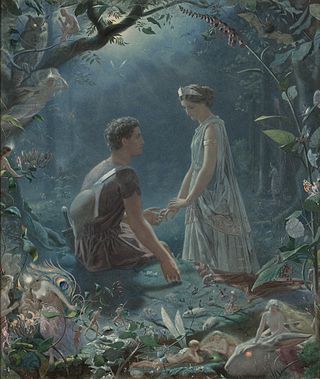
John Simmons (1823–1876) was a British miniature painter and illustrator, known primarily for his watercolours of ethereal fairyland scenes, often illustrating Shakespearian or other literary works. He was one of several popular Victorian artists who together created "a genre of forest idyll" in their fairy paintings. They are often grouped with the Pre-Raphaelites. Simmons lived in Bristol, and also painted portraits. He was elected to membership of the Bristol Academy of the Fine Arts in 1849. He died in November 1876 and is buried at Arnos Vale Cemetery.

The Quarrel of Oberon and Titania is an oil on canvas painting by the Scottish artist Sir Joseph Noel Paton. Painted in 1849, it depicts the scene from William Shakespeare's comedy play A Midsummer Night's Dream, when the fairy queen Titania and fairy king Oberon quarrel; Oberon was considered the King of the fairies in medieval and Renaissance literature. When exhibited in Edinburgh during 1850, it was declared as the "painting of the season". It was acquired by the National Gallery of Scotland in 1897, having initially been bought by the Royal Association for Promoting the Fine Arts in Scotland during 1850. An earlier version of this painting was Paton's diploma picture, which was submitted to the Royal Scottish Academy in 1846; they paid £700 for it.

Victorian painting refers to the distinctive styles of painting in the United Kingdom during the reign of Queen Victoria (1837–1901). Victoria's early reign was characterised by rapid industrial development and social and political change, which made the United Kingdom one of the most powerful and advanced nations in the world. Painting in the early years of her reign was dominated by the Royal Academy of Arts and by the theories of its first president, Joshua Reynolds. Reynolds and the academy were strongly influenced by the Italian Renaissance painter Raphael, and believed that it was the role of an artist to make the subject of their work appear as noble and idealised as possible. This had proved a successful approach for artists in the pre-industrial period, where the main subjects of artistic commissions were portraits of the nobility and military and historical scenes. By the time of Victoria's accession to the throne, this approach was coming to be seen as stale and outdated. The rise of the wealthy middle class had changed the art market, and a generation who had grown up in an industrial age believed in the importance of accuracy and attention to detail, and that the role of art was to reflect the world, not to idealise it.

Titania and Bottom is an oil painting by the Anglo-Swiss painter Henry Fuseli. It dates to around 1790 and is displayed at Tate Britain, in London. It was commissioned for the Boydell Shakespeare Gallery and depicts a scene from A Midsummer Night's Dream by William Shakespeare.
